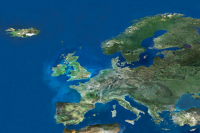Gateway to Think Tanks
| 来源类型 | Publications - Editorials |
| 规范类型 | 评论 |
| DOI | 978-2-86592-788-3 |
| The Evolving Architecture of Space and Security Actuelles de l'Ifri, The Europe & Space Series, No. 1, November 2010 | |
| Christophe VENET; , Laurence NARDON | |
| 发表日期 | 2010-11-17 |
| 出版年 | 2010 |
| 概述 | Today, Europe is taking initiatives both to prevent space weaponization and to develop space militarization. While national States remain the central players in this regard, the intergovernmental European Space Agency is increasingly involved in security-related activities and the European... |
| 摘要 |
The Evolving Architecture of Space and Security Actuelles de l'Ifri, The Europe & Space Series, No. 1, November 2010
Today, Europe is taking initiatives both to prevent space weaponization and to develop space militarization. While national States remain the central players in this regard, the intergovernmental European Space Agency is increasingly involved in security-related activities and the European Union is showing growing political ambitions in this area.  While a small group of European countries led by France launched an observation system for intelligence purposes in the 1980s, Europe only started to take an interest in military space after the end of the Cold War in the 1990s. Military uses of space encompass two broad categories. On the one hand, space assets can be used to support military operations on the ground. This trend, called “space militarization”, started during the Cold War with the intensive use of Earth Observation (EO) and telecommunication satellites by the United States and the Soviet Union. The rise of satellite navigation applications in the early 1990s then allowed space to become a real “force multiplier” for military forces. On the other hand, space could become a war environment in itself, with space systems being targeted by so called anti-satellite weapons (asats). The deployment of such weapons by the U.S. and the Soviet Union never materialized during the Cold War, but the evolution towards “space weaponization” has figured at the top of the international agenda in recent years. It was fueled by the U.S. military space doctrine aiming at “space dominance” and the Chinese asat test of January 2007. While space militarization has been recognized by the UN ever since the 1960s and is today accepted by all countries, space weaponization now appears to most as a dangerous evolution and is the subject of several arms control and confidence-building efforts. Today, Europe is active in both these areas. A number of military applications are developed either by European countries, or under the leadership of the European Union – the future beneficiary within the EU being the Common Security and Defense Policy (CSDP); EU member states also drafted a Code of Conduct (CoC) for Outer Space Activities, an original and key initiative to ensure stability in the space environment.
The Evolving Architecture of Space and Security
|
| 关键词 | European Defense Military strategy Space Strategic autonomy European Union |
| URL | https://www.ifri.org/en/publications/enotes/evolving-architecture-space-and-security |
| 来源智库 | French Institute of International Relations (France) |
| 引用统计 | |
| 资源类型 | 智库出版物 |
| 条目标识符 | http://119.78.100.153/handle/2XGU8XDN/415445 |
| 推荐引用方式 GB/T 7714 | Christophe VENET,, Laurence NARDON. The Evolving Architecture of Space and Security Actuelles de l'Ifri, The Europe & Space Series, No. 1, November 2010. 2010. |
| 条目包含的文件 | ||||||
| 文件名称/大小 | 资源类型 | 版本类型 | 开放类型 | 使用许可 | ||
| europeenvisat.jpg(25KB) | 智库出版物 | 限制开放 | CC BY-NC-SA |  浏览 | ||
| theevolvingarchitect(55KB) | 智库出版物 | 限制开放 | CC BY-NC-SA | 浏览 | ||
除非特别说明,本系统中所有内容都受版权保护,并保留所有权利。